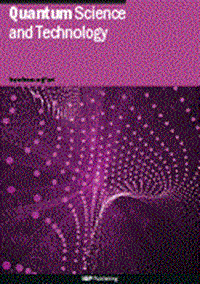Gradient-descent methods for fast quantum state tomography
IF 5
2区 物理与天体物理
Q1 PHYSICS, MULTIDISCIPLINARY
引用次数: 0
Abstract
Quantum state tomography (QST) is a widely employed technique for characterizing the state of a quantum system. However, it is plagued by two fundamental challenges: computational and experimental complexity grows exponentially with the number of qubits, rendering experimental implementation and data post-processing arduous even for moderately sized systems. Here, we introduce gradient-descent (GD) algorithms for the post-processing step of QST in discrete- and continuous-variable systems. To ensure physically valid state reconstruction at each iteration step of the algorithm, we use various density-matrix parameterizations: Cholesky decomposition, Stiefel manifold, and projective normalization. These parameterizations have the added benefit of enabling a rank-controlled ansatz, which simplifies reconstruction when there is prior information about the system. We benchmark the performance of our GD-QST techniques against state-of-the-art methods, including constrained convex optimization, conditional generative adversarial networks, and iterative maximum likelihood estimation. Our comparison focuses on time complexity, iteration counts, data requirements, state rank, and robustness against noise. We find that rank-controlled ansatzes in our stochastic mini-batch GD-QST algorithms effectively handle noisy and incomplete data sets, yielding significantly higher reconstruction fidelity than other methods. Simulations achieving full-rank seven-qubit QST in under three minutes on a standard laptop, with 18 GB of RAM and no dedicated GPU, highlight that GD-QST is computationally more efficient and outperforms other techniques in most scenarios, offering a promising avenue for characterizing noisy intermediate-scale quantum devices. Our Python code for GD-QST algorithms is publicly available at github.com/mstorresh/GD-QST.快速量子态层析成像的梯度下降方法
量子态层析成像(QST)是一种广泛应用的表征量子系统状态的技术。然而,它受到两个基本挑战的困扰:计算和实验复杂性随着量子位的数量呈指数级增长,即使对于中等规模的系统,也会使实验实现和数据后处理变得困难。本文介绍了离散变量和连续变量系统中QST后处理步骤的梯度下降(GD)算法。为了确保在算法的每个迭代步骤中物理有效的状态重建,我们使用了各种密度矩阵参数化:Cholesky分解、Stiefel流形和射影归一化。这些参数化还有一个额外的好处,即启用秩控制的分析,当存在关于系统的先验信息时,这简化了重建。我们将GD-QST技术的性能与最先进的方法进行基准测试,包括约束凸优化、条件生成对抗网络和迭代最大似然估计。我们的比较集中在时间复杂度、迭代次数、数据需求、状态排序和抗噪声的鲁棒性上。我们发现我们的随机小批量GD-QST算法中的秩控制分析有效地处理了噪声和不完整的数据集,产生了比其他方法更高的重建保真度。模拟在标准笔记本电脑上实现全秩7量子位QST在三分钟内,具有18gb RAM和没有专用GPU,突出表明GD-QST在计算上更高效,并且在大多数情况下优于其他技术,为表征嘈杂的中等规模量子设备提供了有前途的途径。我们的GD-QST算法的Python代码可以在github.com/mstorresh/GD-QST上公开获得。
本文章由计算机程序翻译,如有差异,请以英文原文为准。
求助全文
约1分钟内获得全文
求助全文
来源期刊

Quantum Science and Technology
Materials Science-Materials Science (miscellaneous)
CiteScore
11.20
自引率
3.00%
发文量
133
期刊介绍:
Driven by advances in technology and experimental capability, the last decade has seen the emergence of quantum technology: a new praxis for controlling the quantum world. It is now possible to engineer complex, multi-component systems that merge the once distinct fields of quantum optics and condensed matter physics.
Quantum Science and Technology is a new multidisciplinary, electronic-only journal, devoted to publishing research of the highest quality and impact covering theoretical and experimental advances in the fundamental science and application of all quantum-enabled technologies.
 求助内容:
求助内容: 应助结果提醒方式:
应助结果提醒方式:


